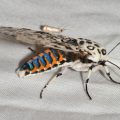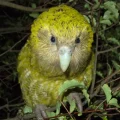The pallid bat is a fascinating species of bat found in arid and semi-arid regions across much of the American west, ranging from Canada to Mexico. Despite its name, the pallid bat is not pale in color, but rather has a yellowish-brown fur that blends in with its desert surroundings.
One of the unique features of the pallid bat is its diet. Unlike other bats that primarily feed on flying insects, the pallid bat preys on ground-dwelling insects and arthropods that are often ignored by other bat species. This includes crickets, grasshoppers, beetles, spiders, cicadas, scorpions, and centipedes. These creatures are all part of the pallid bat’s diet and are essential to its survival.
In order to hunt for its prey, the pallid bat uses echolocation to detect and avoid obstacles while listening for prey-generated noise to localize and hunt terrestrial prey. This means that the bat emits high-pitched sounds that bounce off of objects and prey, allowing the bat to locate and capture its food. This process is facilitated by the bat’s large ears, which are adapted to pick up the faintest of sounds.
Despite its unique adaptations, the pallid bat is a common species throughout its range and is not considered threatened, endangered, or sensitive by most states. However, it is considered a State Monitor species in Washington.
The pallid bat is a fascinating and important species that plays a crucial role in its ecosystem. Its ability to prey on ground-dwelling insects and arthropods helps to control their populations and maintain a healthy balance in the ecosystem. As such, it is important that we continue to protect and conserve this species and their habitats.
What Does A Pallid Bat Eat?
A pallid bat is a ground-dwelling bat species that feeds on a variety of insects and arthropods. These include crickets, grasshoppers, beetles, spiders, cicadas, scorpions, and centipedes. Pallid bats are known to target the ground-dwelling arthropods that are often ignored by other bat species. Their diet consists mainly of animals without a backbone and with exoskeletons. This makes them effective predators of insects and arthropods that reside on the ground. Pallid bats are known to have a varied diet that mainly comprises ground-dwelling insects and arthropods.

Where Can Pallid Bats Be Found?
Pallid bats can be found in arid and semi-arid regions throughout much of the American west, spanning from Canada to Mexico. While they are considered a common species throughout their range, they are typically found in isolated colonies. Some of these colonies have been discovered in northern Oklahoma and southern Kansas.
Is The Pallid Bat Endangered?
According to the state of Washington, the pallid bat is not categorized as threatened, endangered, or sensitive. However, it is considered as a State Monitor species. This means that while the species is not currently at risk of extinction, it is being closely observed and monitored by the state to ensure its population remains stable. It is important to note that the conservation status of the pallid bat may vary in other regions where it is found, so it is important to consult local authorities for accurate information.
Do Pallid Bats Use Echolocation?
Pallid bats use echolocation to navigate their surroundings and locate their prey. Echolocation is a process by which bats emit high-frequency sounds and then listen for the echoes that bounce back from objects in their environment. Based on the timing and intensity of these echoes, bats are able to create a mental map of their surroundings and detect the presence of prey. The pallid bat, in particular, is known for its ability to use echolocation to hunt terrestrial prey such as crickets and scorpions. By emitting sound waves and listening for the echoes that bounce back, these bats are able to locate and capture their prey with remarkable accuracy. echolocation is a crucial tool for the survival of pallid bats and other species of bats, allowing them to navigate and hunt in the dark with exceptional skill and precision.
Conclusion
The pallid bat is a fascinating species of bat that is commonly found in arid and semi-arid regions across much of the American west. Unlike other bats that primarily feed on flying insects, the pallid bat prefers to hunt ground-dwelling arthropods such as crickets, grasshoppers, beetles, spiders, cicadas, scorpions, and centipedes. The pallid bat is an important predator in its ecosystem and plays a significant role in controlling insect populations. This bat species uses echolocation to detect and avoid obstacles while hunting for prey. Although the pallid bat is not considered threatened, endangered, or sensitive, it is still a fascinating species that deserves our attention and protection. the pallid bat is a remarkable creature that showcases the incredible diversity of the animal kingdom.












